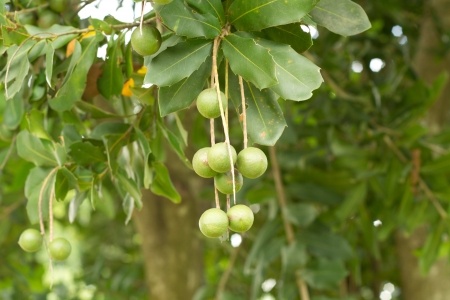Macadamia Nuts

Common Names: Macadamia nut, Macadamia, Macadamia integrifolia, Macadamia tetraphylla, Queensland nut, Australian nut, Bush nut, Hawaii nut, Bauple nut, Maroochi nut, Macadamia ternifolia
Latin Name: Macadamia
Origin: Africa, Asia, Australia, Europe, South America, North America
Short Introduction
The first commercial macadamia orchards were established in the early 1880s by Rous Mill near Lismore in New South Wales, Australia. Although the cultivation of macadamia trees spread throughout Australia by the end of the 19th and start of the 20th century, Hawaii became the main center for large-scale planting around 1920. By 2006, most macadamia nuts were still produced there, but a rapid drop in market prices led to a significant decrease in exports.
Macadamia trees prefer fertile, well-irrigated soils with annual rainfall up to 2000 mm and an optimal temperature of 25°C, rarely dropping below 10°C (though they can briefly withstand light frosts in some climates). Once adapted, they are quite resilient. In Central Europe, macadamia trees are mainly grown as ornamental potted plants. The trees begin bearing nuts at around 7–10 years, and, with proper care, can continue producing for up to 100 years.
Globally, annual macadamia nut production is around 135,000 tons. Approximately 35,000 metric tons are grown each year in Hawaii and Australia, with other major producers including Brazil, South Africa, California, Costa Rica, Kenya, Bolivia, Colombia, Israel, New Zealand, Malawi, and Guatemala.
Detailed Description
Nuts with the potential to lower blood cholesterol levels.
Botanical Information
Macadamia trees are small, evergreen trees that grow between 2–12 meters tall. Their roots are shallow, which makes them susceptible to toppling during heavy rain or storms. The compound leaves are arranged in whorls of 3–6, each elliptical or oval, 6–25 cm long, and finely toothed along the edges.
The individual flowers, measuring 10–20 mm, are grouped into slender, unbranched racemes that can be 5–30 cm long, and are white to pink in color. The fruit is a very tough, hard, oval follicle with a pointed apex, usually containing one or two seeds.
Origin and Distribution
Macadamia originates from eastern Australia, specifically from northeastern New South Wales and central to southeastern Queensland. It is also found in New Caledonia, parts of Queensland, and on Sulawesi (Indonesia).
Usage / Dosage
The plant was first described by the European explorer and botanist Allan Cunningham in 1828, south of Brisbane. Today, macadamia remains one of the few Australian endemic crops exported worldwide in vast quantities due to its high popularity.
An experimental team from the University of Hawaii found that a diet rich in macadamia nuts—despite their high fat content—could paradoxically reduce plasma cholesterol levels. Dr. J. David Curb, professor of geriatrics and clinical epidemiology, stated that macadamia nuts can form part of a healthy diet for patients with hypercholesterolemia (results similar to those for walnuts, almonds, and pecans), thanks to their content of monounsaturated fatty acids, which help lower cholesterol.
A notable study published in the Archives of Internal Medicine compared three diets over four weeks: a typical American diet (with 37% of calories from fat), a similar-calorie diet where the source of fat was macadamia nuts, and a strict diet (30% of calories from fat) developed by the American Heart Association. The trial involved 15 men and 15 women aged between 18 and 59, all with similar body weights and eating in identical conditions.
The results showed total plasma cholesterol was the same for the low-fat diet with macadamias and lower than the American diet. The group on the macadamia nut diet had the lowest levels of free triglycerides. No side effects from eating macadamia nuts were observed, confirming previous studies on their safety even with regular consumption.
The nut's active compounds (mainly monounsaturated fatty acids) show a cholesterol-lowering effect in several studies. Palmitoleic acid was the focus of a 1999 study, which discussed its possible benefit in dissolving blood clots, potentially helping to prevent heart attack and stroke.
Another 1999 French study investigated the benefit of regular nut or nut oil consumption, noting that consumers had higher HDL (good cholesterol) and Apo A1 concentrations compared to those not consuming nuts in the same region.
One notable publication from the American Heart Association followed roughly 22,000 randomly selected male patients for 12 years, finding that those who included a high proportion of nuts in their diet had a lower incidence of cardiovascular-related deaths.
Researchers at New Mexico State University recently reported a reduction in LDL (the "bad") cholesterol, which is responsible for heart problems, with regular macadamia nut consumption. Another study with men showed a modest decrease in total cholesterol over four weeks with moderate daily intake (10–35 nuts per day). On average, total cholesterol fell by 3%, LDL cholesterol by 5%, and HDL cholesterol increased by 8% compared to the start of the experiment.
Active Compounds
100 grams of macadamia nuts provide around 740 calories. They are an excellent source of vitamins B1 and B6 and are rich in free fatty acids, carbohydrates, fiber, and proteins. Compared to other nuts, macadamias have slightly less protein but a higher content of monounsaturated fatty acids (including omega-palmitoleic acid and others).
Important minerals provided include manganese (up to 200% of daily needs), iron, phosphorus, and magnesium. Macadamia nuts are also rich in sodium, zinc, folic acid, vitamin E, and carbohydrates.
Traditional Dosage
For lowering cholesterol, recommended consumption varies between studies. One recommends 10–35 nuts per day; another suggests 15–40 per day; and yet another recommends 40–90 grams, corresponding to roughly 15–40 nuts daily. According to traditional use, there is no official limit or recommended dose.
